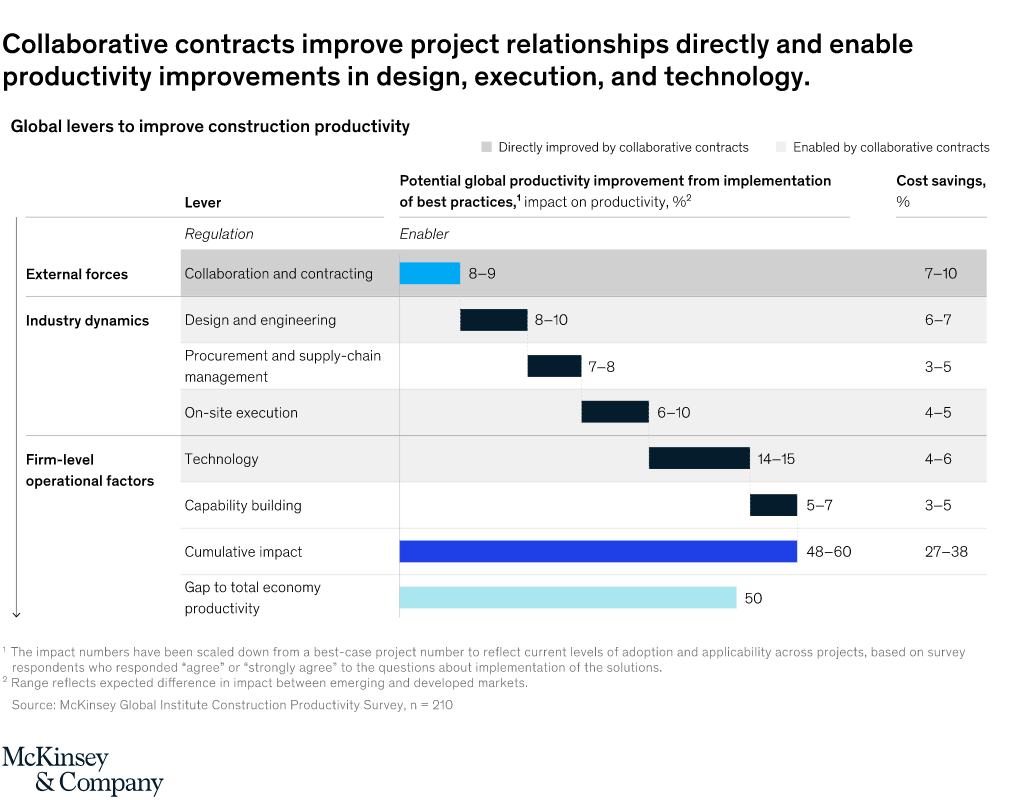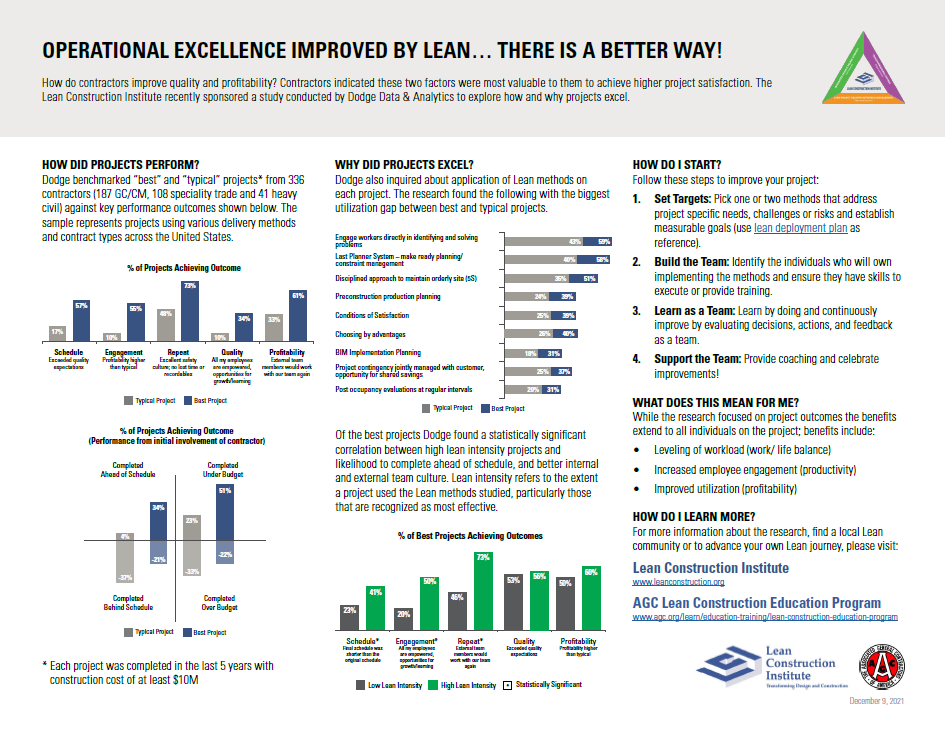Giving Construction Productivity a Boost with AWP, IPD, and Lean

Project delivery systems have to change if the industry is going to solve the construction productivity dilemma.
Advanced Work Packaging (AWP), Integrated Project Delivery (IPD), and Lean Construction are three project delivery systems that show promise in this regard.
Each system has documented success with impressive results, and they all share one significant thing in common: Collaboration.
Early collaboration between owners, design and engineering teams, procurement, and construction contractors deliver projects more safely, productively, and profitably.
Table of contents
- What is Advanced Work Packaging (AWP)?
- The result of Advanced Work Packaging on construction productivity
- What is Integrated Project Delivery (IPD)?
- The effect of Integrated Project Delivery (IPD) on construction productivity
- What is lean project delivery in construction?
- The results of a lean approach to construction productivity
- Greater collaboration leads to greater construction productivity
What is Advanced Work Packaging (AWP)?
The Construction Industry Institute (CII) is the not-for-profit research center for the capital projects industry and the creative force behind the Advanced Work Packaging system.
AWP contains plenty of acronyms, so bookmark this handy glossary of abbreviations and definitions for future reference.
AWP is a collaborative system combining engineering, procurement, and construction (EPC).
In AWP, the engineering teams work with procurement and contracting teams to decompose their projects during the design phase.
The teams break down each project into tightly defined work areas and work packages within those work areas.
These engineered work packages (EWPs) include detailed plans and specs for each construction discipline assigned to the work area, from foundations through finishes.
CWPs, or Construction Work Packages, build on the EWPs by calculating the budget, schedule, resources, tools, and safety constraints required to complete the work within each package.
Installation Work Packages, or IWPs, represent blocks of 500 to 1,000 hours of total labor time. Each block of time in an IWP is discipline-specific and includes documentation and sequencing that guides, supports, and directs the work teams in the field during their assigned blocks of time.
If breaking down work like this looks familiar, you’re right. However, the AWP system takes work breakdown structures (WBS) to a more profound, detailed, and interactive level.
But what makes AWP so effective is that instead of breaking down the work after the project has been let, the work breakdown process is part of the project’s design.
The result of Advanced Work Packaging on construction productivity
By designating specific work areas and sequencing the construction activities within those areas, the AWP system can boast productivity increases of up to 25% with a 10% reduction in total project delivery cost.
Using construction-driven engineering and collaborative work planning, AWP has proven successful in mega-projects, industrial projects, and large-scale capital projects but isn’t used widely in other sectors.
Are there elements of the Advanced Work Packaging philosophy you can use to boost the productivity of your operation?
What is Integrated Project Delivery (IPD)?
The Integrated Project Delivery method is a joint effort of the National Association of State Facilities Administrators (NASFA); Construction Owners Association of America (COAA); APPA: The Association of Higher Education Facilities Officers; Associated General Contractors of America (AGC); and American Institute of Architects (AIA).
The basis of the integrated project delivery model is simple.
A single contract brings together owners, designers, suppliers, contractors, and facility operators to share the risk and reward of completing a successful project.
IPD eliminates the competition and adversarial relationships that plague most construction projects.
Under an IPD agreement, project stakeholders form a new entity, a Single Purpose Entity (SPE). These single-purpose entities can be either contractual or agreed to in spirit.
The American Institue of Architects (AIA) suggests several variations are possible within IPD agreements and advises they include the following at the very minimum:
- The parties join a single contract or an umbrella agreement;
- The agreement creates a temporary, virtual or formal organization complete with management and decision-making processes;
- Tailored processes support the team environment;
- Decisions are arrived at through consensus and seek “best for project” outcomes;
- Link compensation to the project success, not an individual entity’s success; and
- Assign roles to the person or entity best capable of performing them.
These collaborative teams explore ways to deliver more value faster and at a lower cost by sharing their collective knowledge and experience early in the conceptual phase. And then these teams work together to bring the project to successful completion.
The effect of Integrated Project Delivery (IPD) on construction productivity
Integrated Project Delivery (IPD) systems increase productivity by 20% on average, with some research suggesting the potential for even more significant gains.

And the good news is that IPD is very flexible.
The level of comfort public owners have with collaboration depends on several factors, including legislative restraints, policy limitations, and cultural barriers.
Towards this end, Integrated Project Delivery agreements are flexible.
Modifications fall into three basic levels.
- Collaboration Level One – Typical; collaboration not contractually required
- Collaboration Level Two – Enhanced; some contractual collaboration requirements
- Collaboration Level Three – Required; a multi-party contract with collaboration required
It’s interesting to note that the level of collaboration is closely related to the benefits experienced in safety, productivity, and profitability.
The greater the level of collaboration is, the greater the benefits become.
What is lean project delivery in construction?
Lean Project Delivery and IPD share many of the same principles.
The Lean Construction Institute (LCI) has developed an Integrated Project Delivery model called the Lean Project Delivery System ™ (LPDS).
Lean principles focus on continuous improvement through two primary objectives:
- Continuous elimination of waste; and
- The creation and flow of value with minimal interruption.
The eight wastes in lean project delivery philosophy
Waste, in lean terminology, is anything that does not provide value to the customer.
The causes of waste follow the pneumonic D.O.W.N.T.I.M.E.
- Defects
- Overproduction
- Waiting
- Non-utilized talent
- Transportation
- Inventory
- Motion
- Extra Processing
The results of a lean approach to construction productivity
Lean principles have proven highly effective in improving productivity in the manufacturing sector since the early 1950s. And just like the Integrated Project Delivery model, the benefits of lean principles are directly correlated with the extent to which they’re used.
The Lean Construction Institute (LCI) holds that by simply focusing on the following six tenets, organizations can improve:
- Respect for People
- Removal of Waste
- Focus on Process & Flow
- Generation of Value
- Continuous Improvement
- Optimize the Whole
And the results speak for themselves.
Lean construction principles increase on-time delivery by up to 34%. And lean thinking organizations also claim fewer work injuries and fatalities as well.
Project teams lessen the risk associated with re-work by eliminating waste, excess inventory, unnecessary motion, and the errors those conditions cause. And research finds a strong correlation between re-work, workplace injuries and fatalities.

Greater collaboration leads to greater construction productivity
Each of these project delivery systems promises impressive results, and they all share one crucial thing in common: The success of each system relies on collaboration
Organizations that focus on building collaborative relationships with their project owners, design teams, subcontractors, and suppliers will lead the construction industry into the future.
Integrated collaborative software platforms make building these critical relationships easier.
From better communication, interactive scheduling, detailed workflow, and job site management, collaborative project management platforms can help build a stronger, more resilient financial future for our industry.
Get a free demonstration for yourself.
And see how the power of collaboration can secure your future with Linarc.




